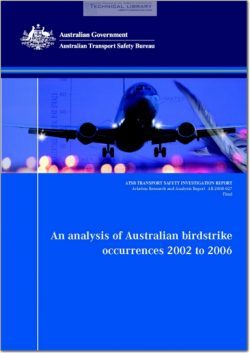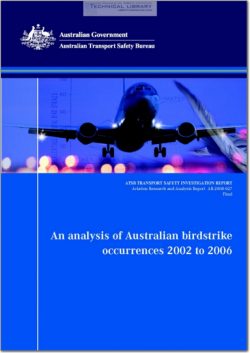ATSB-AR-2008-027

- Version
- 183 Downloads
- 2.74 MB File Size
- 1 File Count
- August 9, 2016 Create Date
- August 9, 2016 Last Updated
An Analysis of Australian Birdstrike Occurrences - 2002 to 2006

The Australian Transport Safety Bureau (ATSB) released a discussion paper in
2002 on birdstrikes in Australia between 1991 and 2001. In 2003, the ATSB, the
Civil Aviation Safety Authority, and the Australian Aviation Ground Safety
Council met and agreed that an industry consultative forum on bird and animal
hazards to aircraft would meet an important need in aviation. This led to the
formation of a forum, now known as the Australian Animal Wildlife Hazard Group
(AAWHG). Part of the AAWHG mandate is to examine birdstrike research. The
AAWHG requested that the ATSB prepare a report on bird hazards to assist in
examining trends, developing risk assessment models, and priorities. This report
has been prepared in response to that request.
There has been an increase in the number of birdstrike occurrences reported to the
ATSB. In Australia, over the last five years, the number of birdstrike occurrences
reported annually to the Australian Transport Safety Bureau (ATSB) has risen from
approximately 750 in 2002 to 1,200 in 2006. This investigation aims to examine the
possible influences on and reasons for this increase and explore any areas of
important or emerging risks related to birdstrike occurrences in Australia.
Many birdstrikes are reported to the ATSB more than once. Aerodrome ground
staff were responsible for about 30 per cent of all birdstrike reports, Air Traffic
Services (ATS) about 25 per cent, and flight crew and/or operators for just over 40
per cent of reports. Those proportions were also true for reports originating from
major aerodromes and regional aerodromes. General Aviation Airport Procedures
(GAAP) aerodromes had more reports from ATS and less from flight crew and/or
operators, while the ‘Other aerodromes’ category had two-thirds of reports coming
from flight crew and/or operators as a result of minimal ATS involvement at those
locations.
| File | Action |
|---|---|
| ATSB-AR-2008-027 An Analysis of Australian Birdstrike Occurrences - 2002 to 2006.pdf | Download |

Comment On This Post